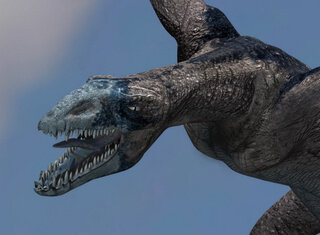Raptors

Raptors are large mutated Eagles that greatly resemble prehistoric pterodactyls. The resemblance is so great that many believe that these creatures were either genetically engineered by the Ancients or were somehow brought back to life after being extinct for millions of years.
Physically, they look like gigantic winged reptiles. They don’t have beaks; instead they have large toothy maws and small beady eyes that would put the eyes of an Eagle to shame. They are approximately ten feet from snout to tail and have a wingspan of nearly forty feet. They are surprisingly light though, most weighing less than 200 pounds.
Chris Van Deelen is the author of the Skirmisher Publishing LLC sourcebook Creatures of the Tropical Wastes sourcebook, co-author of its Wisdom from the Wastelands game supplement and contributor to the 'Sword of Kos: Hekaton' Anthology.
No. Enc: 4d10
Alignment: Neutral
Movement: 30’ (10’) Ground
300’ (100’) Fly
AC: 2 (6 on the ground)
HD: 7
Attacks: 1 bite or 2 claws (and special, see description), or 1 wing buff
Damage: 2d6 or 2d8 / 2d8 or 1d8 and special
Save: L7
Morale: 10
Hoard Class: None
Raptors are large mutated Eagles that greatly resemble prehistoric pterodactyls. The resemblance is so great that many believe that these creatures were either genetically engineered by the Ancients or were somehow brought back to life after being extinct for millions of years.
Physically, they look like gigantic winged reptiles. They don’t have beaks; instead they have large toothy maws and small beady eyes that would put the eyes of an Eagle to shame. They are approximately ten feet from snout to tail and have a wingspan of nearly forty feet. They are surprisingly light though, most weighing less than 200 pounds.
The skin coloration is usually tan, but like that of a chameleon, these creatures skin changes color to match its surroundings. So when they are flying on a clear sunny day, the underside is blue, while the upper side matches the ground beneath them. If they are basking on the sand, they will be sandy coloured, or if they are high in the trees or cliffs, their skin will change to match.
These creatures can only survive in hot climates. They are pure reptiles and as such are cold-blooded, incapable of maintaining their own body temperature. As a result, they are only found in tropical locations where food is plentiful.
They live together in large colonies. One or two can usually be handled without too much difficulty, but when they are together in large flocks, even the most stalwart hunters tend to flee in fear.
These mutant creatures are graceful and incredibly fast fliers, owning the skies around them. A single flock will claim a territory of approximately 100 square miles in diameter, and will viciously attack any other Raptors that come into this territory.
They are slow and clumsy on the ground and will do everything they can to avoid being grounded if at all possible. It is when they are on the ground that they are most vulnerable (they suffer an addition of +4 to their AC).
In combat, the creatures will use one of several attacks. First, if they are engaged with an aerial opponent, they will try to claw and shred its wings. If both claw attacks hit in a single round, the target must make a save versus stun or have its wings damaged. If this occurs, the creature falls from the sky, incapable of flight. A second save against stun is allowed, letting the creature ‘glide’ to the ground to avoid falling damage. The creature cannot fly until all damage has been healed.
When they are engaging an opponent on the ground, they tend to bite, or slap with their wings. Any creature hit by the wings must save versus stun or either be stunned for 1d4 rounds or be knocked prone (Mutant Lord’s choice).
These creatures live high up in trees, inaccessible ruins or cliff faces. They build their nests in these locations and once every 2 years they lay clutches of 1d4 eggs. The eggs take 4 months to develop and once the young Raptors hatch, they have to stay in the nests until they are 1 year of age.
After they reach this age, the young are capable of flying and leave the nest. It takes another 4 years for these creatures to reach full maturity.
These mutant reptiles have the intellect of a bird, and have no use for any sort of treasure or artifacts, although these items can occasionally be found in the nests, the left over remnants from previous victims (GM to decide if anything is found).
Mutations: Chameleon epidermis, gigantism, increased senses (sight)
Source: Warbirds (2008)



